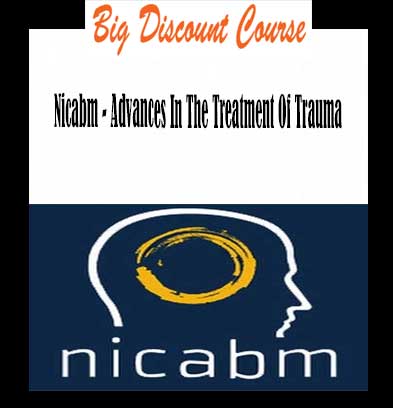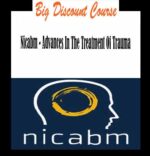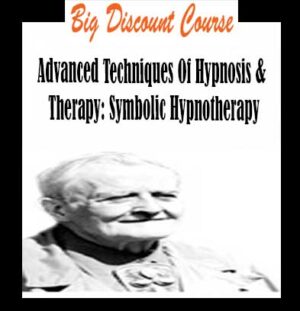Description
Advances In The Treatment Of Trauma, Nicabm – Advances In The Treatment Of Trauma, Advances In The Treatment Of Trauma download, Nicabm – Advances In The Treatment Of Trauma review
Nicabm – Advances In The Treatment Of Trauma
Breakthrough Treatments For Trauma Are Reducing Symptoms, Shortening Treatment Time, and Helping Patients Recover Their Lives.
How to use the advances in brain functioning, somatics, vagal nerve response and attachment to get faster results with your trauma patients
WHAT NEUROSCIENCE TEACHES US ABOUT THE TREATMENT OF TRAUMA
BESSEL VAN DER KOLK, MD
Co-author of Traumatic Stress: The Effects of Overwhelming Experience on Mind, Body, and Society, Medical Director of the Trauma Center at Justice Research Institute, Faculty at Boston University Medical School
How trauma affects the brain
Why understanding how traumatic memories are stored is key to planning your treatment
How trauma can destroy one’s sense of time and why this is so critical to recover
The four components of an effective trauma treatment
The effect of child abuse and neglect upon neurodevelopment
Common mistakes practitioners make
Can yoga reverse the secondary brain damage caused by trauma?
INTEGRATING THE BODY IN TRAUMA TREATMENT – A SENSORIMOTOR APPROACH
PAT OGDEN, PHD
Author of Trauma and the Body, Founder & Director of The Sensorimotor Psychotherapy Institute
Uncovering root causes – the long-term effects of attachment issues
How to manage the arousal and integration problems caused by trauma
How to help your patients safely expand their window of tolerance
Using polyvagal theory to help regulate arousal
How mindfulness can create positive connections to the body
POLYVAGAL THEORY: WHY THIS CHANGES EVERYTHING
STEPHEN PORGES, PHD
Author of The Polyvagal Theory, Professor at University of Illinois at Chicago
How to use heart rate variability as a portal to self-regulation
The key missing ingredient in the fight/flight theory
How polyvagal theory clarifies the role of fear in unresolved trauma
Why vagal regulation affects our interactions with others
How music cues vagal regulation and why this could help your trauma patients
Polyvagal theory and working with children
How to increase psychological safety in hospital settings
GUIDED IMAGERY FOR TRAUMA RECOVERY (INEXPENSIVE, ACCESSIBLE, AND EFFECTIVE)
BELLERUTH NAPARSTEK, LISW
Author of Invisible Heroes and Staying Well With Guided Imagery, Creator of the Health Journeys guided imagery audio series
Getting the “D†out of PTSD
Why guided imagery is especially effective with people who have been traumatized
How to overcome treatment barriers with combat veterans
The treatment of moral injury and why it can be essential in working with soldiers
Common mistakes practitioners make in working with military personnel
Using the internet to connect with survivors of tragedy
THE NEUROBIOLOGY OF TRAUMA – WHAT IS HAPPENING IN THE BRAIN OF SOMEONE WITH UNRESOLVED TRAUMA
RUTH LANIUS, MD, PHD
Co-Editor of The Impact of Early Life Trauma on Health and Disease, Faculty at University of Western Ontario
Four important deficits found in people with early childhood trauma
The effect of childhood trauma on relationships – and what this means for treatment
How trauma alters connections within the brain
Strategies to repair the three areas of self damaged by early life trauma
The unique benefits of using a Stage-Oriented Approach to treatment
HOW TRAUMA AFFECTS INTIMATE RELATIONSHIPS
SUE JOHNSON, EDD
Author of Hold Me Tight and Emotionally Focused Couple Therapy with Trauma Survivors, Director of the International Center for Excellence in Emotionally Focused Therapy
How to use couples therapy to strengthen attachment bonds in the face of trauma
Unique problems (and opportunities) in couples therapy with trauma survivors and their partners
Special considerations for first responder or military families
How to use emotionally focused couples therapy for treating trauma
DEAR COLLEAGUE,
Trauma touches everyone.
Its effects ripple out to entire families and communities, and the results can be devastating.
But some practitioners, working with leading-edge researchers, have developed specific new interventions and treatment protocols that are getting quicker, more targeted results.
What are they? And what do you need to know to create the best treatment for each of your trauma patients?
To answer these critical questions we built a comprehensive training program that brings the leading experts together in a forum to share what’s working – and what’s NOT.
Each session in this comprehensive training program is packed with critical information so that by the end, you will know how to use the latest developments to reduce debilitating symptoms, shorten treatment times, and help your trauma patients recover their lives.
You will have access to each of these expert presentations online.
CAN TRAUMA “RUB OFF�
Sounds silly, but you’d be amazed how many psychotherapists, physicians, nurses, police, firefighters and others in the care-taking professions are struggling with “secondary trauma†issues.
This type of “transference†happens far more frequently than previously realized.
To protect yourself and maintain your ability to help others, you need to know:
The three factors that influence tolerance to secondary stress
How we create self-induced trauma in our hospitals and mental health agencies
Why helping professionals are so addicted to intensity that they can’t go home
The tools you must use regularly to effectively counteract secondary stress
Pay attention! These telltale signs may mean you and your staff are at risk for secondary trauma.
That’s why we’ve added this special bonus for our gold members.
THESE VALUABLE SESSIONS CAN GET YOU QUICKLY ONBOARD WITH THE VERY BEST TREATMENTS TO USE WITH YOUR PATIENTS
The New Treatments for Trauma comprehensive training program brings a never-before group of experts together.
We’ll give you a specially prepared agenda so that you have the framework for participating in each session.
You’ll see how their applications can have a direct impact and how they can change the work you do. And at the end of each session we’ll dive into even more applications with Rick Hanson, PhD and Bill O’Hanlon, MS so that you leave with take-home ideas every week.
The interviews are candid, in depth, and far-reaching.
They will reveal how you can use the latest trauma treatments in your work.
What can you expect to get from this new comprehensive training program?
Power-packed interviews with leaders in the field
Total focus on learning and skill building that you can implement immediately
Hands-on examples on how you can bring healing to unresolved trauma wounds







